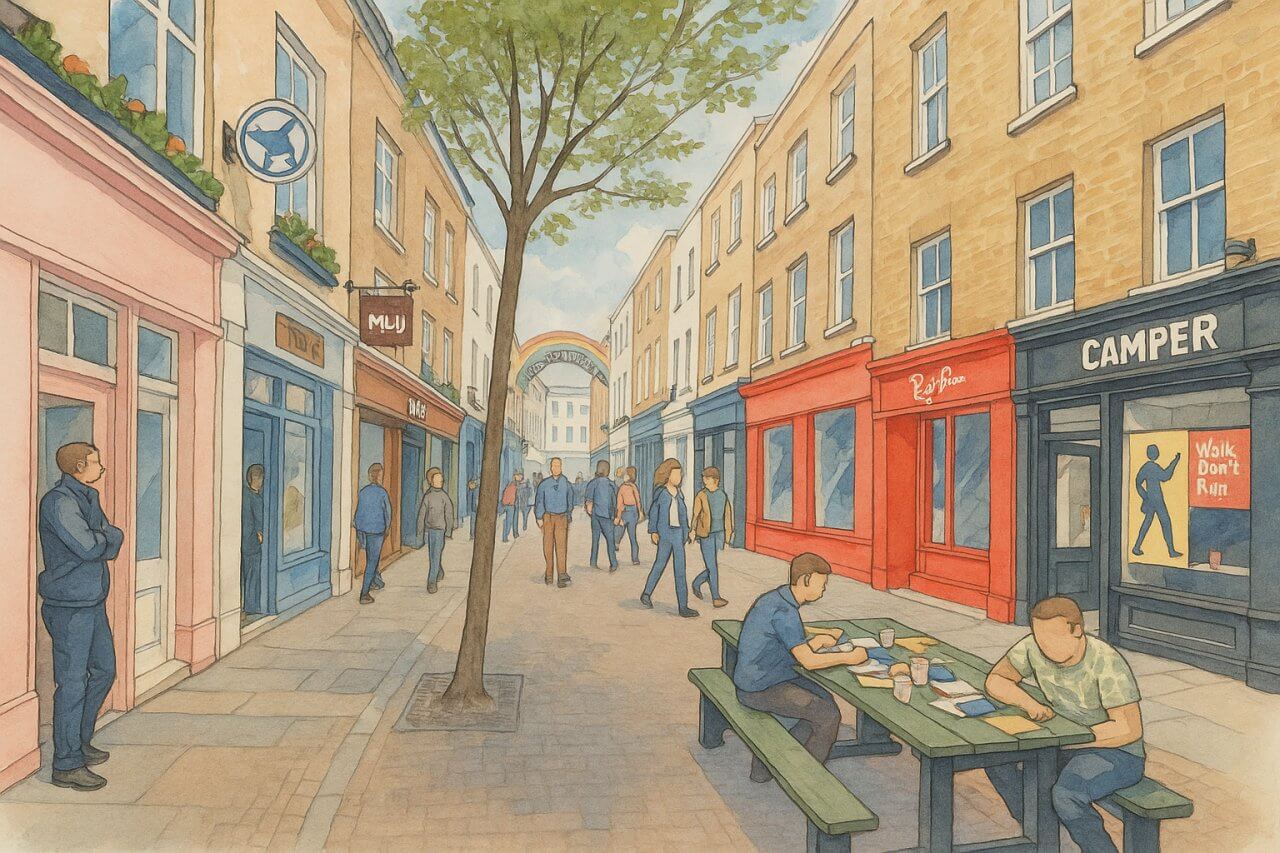
Carnaby Street, London
Carnaby Street is located in the Soho district of the City of Westminster, in central London. It runs roughly north to south, connecting Great Marlborough Street at its northern end to Beak Street at its southern tip.
The street lies just east of Regent Street and parallel to Kingly Street, nestled within the area widely known as Carnaby, which includes several smaller pedestrianised streets such as Ganton Street and Foubert’s Place.
Length and Layout
Carnaby Street itself is a relatively short road, measuring around 0.1 miles or approximately 160 metres in length. It forms the central spine of the Carnaby retail district, a walkable zone of interlinked streets and alleyways full of shops, cafés, and restaurants.
While not a square, the broader Carnaby area often feels like a contained urban village. The pedestrianised layout and central plaza areas like Kingly Court give it the feel of an open-air complex rather than a single linear road.
History of Carnaby Street
Carnaby Street was laid out in 1682, during the rapid urban development of London in the Restoration period. It took shape amidst the burgeoning area of Soho, which was transforming from rural pastureland into a dense neighbourhood of streets, trades, and residences.
Initially a modest residential street, Carnaby grew in prominence over the centuries, especially in the 19th century, when it began attracting small shops and workshops. However, it wasn’t until the 20th century that its cultural significance truly emerged.
Origin of the Name
The street is believed to have been named after Carnaby House, an early building constructed nearby in 1683. The origin of the name “Carnaby” itself is somewhat obscure, but it is thought to derive from a surname, possibly Scandinavian or Norse in origin, that was in use in England during the medieval period.
By the early 18th century, the name Carnaby Street was firmly established on maps and in official documents.
Character of the Street Today
Today, Carnaby Street is one of London’s most iconic shopping and lifestyle destinations. It is famous for its vibrant atmosphere, creative boutiques, and independent labels, as well as major international fashion brands.
The street’s pedestrian-only layout adds to its appeal, offering a unique shopping experience free from vehicle traffic. In addition to fashion, Carnaby is home to quirky gift shops, trendy restaurants, and street art installations that change with the seasons.
The street’s pedestrian-only layout adds to its appeal, offering a unique shopping experience free from vehicle traffic. In fact, Carnaby Street was officially pedestrianised in 1973, having previously been open to cars. The move came in response to increasing footfall and congestion, and was part of a wider urban design shift in the 1970s to improve public spaces and prioritise pedestrians in retail-heavy zones.
At its heart is Kingly Court, a three-storey courtyard filled with eateries offering global cuisines and stylish al fresco dining.
Property and Real Estate Values
As of early 2025, Carnaby Street remains one of London’s most valuable retail locations. Retail units here command some of the highest rents in the West End, with small shops (around 600–1,000 sq ft / 55–93 sq m) leasing for prices starting around £250,000 per annum, depending on the frontage and visibility.
While there are very few residential properties on Carnaby Street itself, nearby Soho apartments (ranging from 500–900 sq ft / 46–84 sq m) often sell for upwards of £1.5 million, reflecting the area’s prime central location and cultural desirability.
Nearest Underground Stations
Carnaby Street is extremely well-served by the London Underground. The nearest stations are:
- Oxford Circus (Bakerloo, Central, and Victoria lines) – about 4 minutes’ walk
- Piccadilly Circus (Bakerloo and Piccadilly lines) – about 7 minutes’ walk
- Tottenham Court Road (Central, Northern, and Elizabeth lines) – around 10 minutes on foot
The central location makes it easily accessible from all parts of London and popular with both tourists and locals.
Fun Fact
During the 1960s, Carnaby Street became internationally famous as the epicentre of ‘Swinging London’. It was closely associated with the Mod fashion scene, The Beatles, The Rolling Stones, and designers like Mary Quant and Lord John.
American visitors flocked to the street, and Carnaby became a symbol of British youth culture, freedom, and style. Even today, street signage on Carnaby celebrates its 1960s heritage with retro-inspired decorations and themed events.
Further Reading
Read about shopping in London to get to know other streets like Carnaby Street which are shopping destinations.Quick Facts
- Location: Soho, City of Westminster, London
- Length: Approx. 160 metres (0.1 miles)
- Established: 1682
- Name origin: Named after Carnaby House (1683)
- Current character: Pedestrianised shopping street with fashion boutiques and restaurants
- Nearest tube stations: Oxford Circus, Piccadilly Circus, Tottenham Court Road
- Retail rents (2025): £250,000+ per year for small units
- Residential prices (2025): £1.5 million+ for flats nearby (500–900 sq ft / 46–84 sq m)
- Tourist interest: Major 1960s Mod fashion and music heritage
- Special feature: Home to Kingly Court and seasonal street art displays
Map of Carnaby Street, London

Painting of Carnaby Street, London (View image in full size)